Dilute the heating in the house. Two-pipe heating - disadvantages and advantages. The principle of classification schemes and types of heating systems
Both the owners of apartments and the individual housing construction are arguing over what kind of heating layout from a boiler in a private house is better - collector, or better to apply its design. Many years of experience in creating and using heating systems shows that for each housing it is necessary to select its own scheme for distributing heating pipes in the house.
The principle of classification schemes and types of heating systems
Domostroenie private in terms of arrangement of heating in the house is preferable to the apartment for many reasons:- The possibility to use any scheme of heating a house of a private nature, regardless of the area of the building.
- Effective heating distribution is initiated in a two-story or one-story residential building.
- Implementation of the system or the natural type of coolant circulation.
- Installation of any type of pipes and radiators connected from the boiler.
- Uniform accelerated warming up of all living quarters due to the fact that the collector heating distribution works.
- The ability to monitor fuel consumption and, as a result, budget savings.
In practice, the distribution of heating in the house is used more often, for single-tube, beam (collector) or "Leningrad" schemes. And any of the listed systems has both advantages and disadvantages, which must be taken into account when drafting engineering and other communications.
Mounting by type of coolant circulation
The movement of the coolant along the heating system of the heating system can be implemented forcibly ( circulation pump) or in a natural way, due to the difference in heights (in the life of such a project is called "physics").A good option is to use these two methods simultaneously. So, you will achieve continuous operation of the system even when the circulation pump is off, when electricity suddenly turned off.
A section of the thermal circuit, along which the coolant is fed to the radiators, is called a straight stroke (or direct current, feed). In radiators hot water cools, then it returns to the boiler, where it is again heated to the desired temperature. This segment of the closed heating cycle is called reverse motion (or reverse current, reverse flow).
In order for the coolant to move faster, and also faster room heating, a heat pump (usually a reverse current loop) is built in a pump operating in a circulating manner. Many modern models of boilers have their own built-in pump, so the distribution of heating pipes in a private house is easier and easier.

How to organize the circulation of a natural coolant
If it is possible to organize natural circulation through the heat conductor, then you will save on the pump and the consumption of electricity. The disadvantage of this connection is the slow warming up of batteries and rooms, as hot water moves "by gravity". Circulation of heating from the boiler through the system is provided not only due to the difference in heights at the start and end points of the heating system, but also because the density of the coolant changes with heating and cooling - hot water is easier.Cooled coolant from the reverse current displaces the hot water from the boiler into the main line of the direct flow, and it flows into the horizontal water supply of heating in a one-story or two-three-story house. When organizing the gradient of the main line at 3-50 the circulation pump can not be installed - the water will move by gravity.

If you absolutely do not know how to make a heating layout in a private house, implement the principle of natural water circulation, since this is the simplest option. Simplicity consists in the rejection of the collector - there will be no need for radial heating in the private house - there is no pump, there is no pressure in the system, which ensures the operation of the collector.
The drawbacks of this scheme are two: such a distribution of the heating system in a private house effectively works only for a small area of housing. And pipes for the distribution of coolant it is desirable to install a diameter of 80 mm - so you will provide faster heating of premises and unhindered circulation of hot water.
Principle of forced circulation
The pump is a mandatory node in such a system. This scheme of heating distribution two-story house or a single-storey building allows not to comply with the main gradient, and even allows its negative value, as well as the connection of pipes under any slope and angle. The next advantage - in any case, can be used radial heating in a private house (collector).The disadvantage is the lack of autonomy. In case of a power failure, the heating system stops functioning. If you live in a private house of individual construction, then you can use a diesel generator in the absence of electricity.
Advantages and disadvantages of a single-pipe circuit
Self-wiring heating in a two-story house according to a single-pipe design of a simple or "Leningrad" scheme is based on the fact that the hot carrier moves along all the radiators sequentially. This connection is chosen based on budget savings.Minuses:
- it is impossible to provide separate temperature control in each room;
- the batteries cool down the more the further they are from the boiler.
Minimum costs for materials, minimum labor costs are the advantages of heating in a wooden, concrete, block or brick house.

"Leningrad" project solves the problem with the temperature adjustment in each radiator, and, therefore, in each room separately. This is done with the help of tie-in valves (valves) and (bypass pipe), which ensures full circulation of hot water, if some radiator needs to be excluded from the wiring.
Pros and cons of a two-pipe scheme
When deciding how to make a heating distribution in a two-story house, it is recommended to stop on a two-pipe scheme. A properly installed two-pipe circuit provides connection of each radiator to both the direct current and the return pipes.Such a project is more wasteful in terms of materials, but it makes it possible to apply collector circuit connecting the batteries, and adjust the temperature in each radiator individually.
For heating in a single-story house, such installation of the connection will not work, and in a house of several floors height it will work with maximum efficiency.
The construction of a vertical two-pipe system involves two approaches: the distribution of heating pipes in a private house of the lower and upper types:
Two-pipe top wiring
How to make a heating layout in a private house under this scheme? The pipe from the boiler is held under the roof of the last floor or in the attic. Down the hot water moves along the risers through the radiators, and returning, again gets back into the boiler. Air is discharged from the system through the expansion tank. This is the best solution from the existing ones, since high blood pressure in the highway.
Three types of horizontal wiring
Horizontal heating scheme in a single-story house with two pipes and forced circulation is the most popular installation option. The wiring diagrams are as follows:
- Deadlock installation provides material savings, but it is necessary to mount a too long main circuit from the boiler to the last radiator. Therefore, it is difficult to regulate the temperature in the rooms.
- Parallel progress of the coolant is achieved by the same length of all thermal circuits. Pipes will be needed more, but the effect of heat recovery is clearly stronger. The disadvantage is that it is difficult to hide behind the false panels, which spoils the interior.
- Collector (beam) scheme of distribution of hot water. Each battery is connected to the collector, and fast, uniform heating of the rooms connected to the boiler is always ensured. Cons: the most costly method of installation, large consumption of materials. Pipes can be laid under a concrete screed or in wall finches, but this is also additional costs ..
How to make a heating system (video)
The video describes the most popular and reliable scheme for routing pipes in a low-rise building. The advantages are described collector wiring, the connection of automation and the combination of the heating system with a small area of premises.The distribution of heating by one's own hands is not such a simple matter as it may seem. Special knowledge and calculations are required for its implementation. Of course, you can not complicate and implement the simplest, but from this not lacking efficiency method described in the article and demonstrated in the video.
Heating, water supply and sewerage are three whales, on which there is a comfort of home. The correct choice of wiring of the heating system in the house will create a cost-effective and efficient heat supply. The design of the heat supply scheme and the construction of the building are carried out simultaneously, since in this case possible nuances are taken into account.
Types of heating layouts
The burden on providing heat in private housing construction falls, with the exception of fireplaces and stoves, on heating boilers. They are one- and two-circuit. Single-circuit heating devices are used only for house heating, and boilers with two circuits additionally provide hot water.
When creating a heating system, the type of boiler equipment does not matter. For the transfer of the coolant and the transfer of heat energy to the premises, two options are used: one- or two-tube. This is taken into account when thinking through the design of the building.
Single pipe distribution
Heating distribution is a circuit consisting of a single pipe, to which are connected in series heating devices. It is arranged horizontally or vertically.
Horizontal layout of a simple design. To create a workable system requires the organization of a slope for the movement of the coolant.
Radiators
For heating several floors using this method, when the coolant is fed to a higher level, the valve cuts in before entering the first section of the radiator. It is required for the required fluid pressure when fed upward. This is achieved through its partial overlapping.
When using vertical wiring, the verticality of the risers should be observed during installation. In this case, a pipe with a large diameter is used as compared to a horizontal circuit, and there is no need for application pumping equipment.
The use of a single-pipe heating system makes it possible to achieve savings by reducing the need for materials, and also simplifies the design and installation work. In this case, the main drawback of this scheme is the loss of thermal energy as it passes through the series connected heating devices. As a result, the quality of the heating at the extreme radiators is not enough.
To correct the situation, the following measures are applied:
- number of sections heating devices increase with distance from the boiler;
- thermostatic valves are mounted which allow to regulate the water supply to the batteries;
- a pump is used to force the coolant through the pipes.
The use of single-tube heating is effective for a house whose area does not exceed 100 sq.m.
Two-pipe heating distribution system
The work of this heating involves the use of two pipes. The first of them supplies the coolant to the batteries, and the other transfers it after the heat transfer and returns to the heating device. The use of such a scheme makes it possible to use any types of boiler equipment irrespective of the energy carrier.
Circulation of fluid occurs naturally or forcibly, while the height of the house does not play a role.
Advantages and disadvantages
The method for creating the circulation of the heat carrier causes a double flow of pipes to create a pipeline. However, it can not be asserted that an increase in costs is proportional to the amount. To create a two-pipe heating system, pipes of smaller diameter are required, and smaller fittings are cheaper.
The installation of this option is complicated, and the laboriousness of the work increases.
 In the heating system, everything is important
In the heating system, everything is important Installation on each heater of the thermostat achieve the required balance temperature conditions in the premises, which is difficult to arrange with a single pipe. This unit maintains the set temperature in automatic mode. The single-tube design is adjustable in the case of a bypass on each battery or when equipped with a three-way valve, which leads to additional costs and complicates the design.
The two-pipe version is inconvenient for repair, since it requires a cut-off of the coolant supply. But when installing ball valves on each radiator that cover the individual feed and return, repair and technically service it without stopping the heating.
The advantage of a two-pipe system is that the coolant is supplied to all batteries directly from of the heating device. This scheme is accompanied by a smaller drop in pressure. It simplifies the creation of a natural movement of the coolant or requires pumping equipment having a lower power for forced movement.
Types of two-pipe heating systems
Heating designs are made in two ways: open and closed. When closed circuit the construction is equipped with a membrane expansion tank. The presence of this device works accident-free in the case of a significant increase in pressure.
 Two-pipe system
Two-pipe system The peculiarity of this system is the possibility of using antifreezes as a coolant, which does not allow defrosting in the event of an accident. And the composition of these liquids is designed specifically for heating. Use of other antifreezes is not allowed. Additives or additives should also have an appropriate purpose. Otherwise, the modern boiler equipment out of service for a reason other than guarantee.
Open-type expansion tank is included in the equipment open system. There is a nozzle used to remove air, and special pipeto remove excess water. In some cases, it supplies hot water for use on the farm. This circumstance requires obligatory automatic feeding, and the presence of additives is excluded.
The safety level of closed structures is higher than that of open ones, which is taken into account in the design of the heating system.
Vertical and horizontal systems
Vertical is used to organize heating of houses from several floors. The design is different material-intensive, but the connection of heating devices is easy. The advantage of this scheme is the automatic removal of air.
 Vertical system
Vertical system Application horizontal system it is advisable to organize heating of houses of small storeys. In order to prevent airborne eruptions, Maevsky cranes are installed.
Upper and lower wiring
The design of the upper wiring provides for the location of the pipe at the ceiling level. The coolant is supplied to the batteries from the top down, and the return is placed on the floor. This arrangement of pipes creates favorable conditions for the construction of heating with natural circulation, while observing the required slope of the pipeline. The installation of such a structure worsens the appearance of the room.
To remedy the situation, methods are used to hide the pipeline (build suspended ceilings or hide pipes in walls).
A characteristic feature of the lower wiring is the delivery pipe assembly at the bottom, but so that it is located above the return. The supply is located in the basement, and the pipes leading and discharging water to the heating devices are passed through the floor. From an aesthetic point of view, this option is preferable. However, when natural circulation It is important that the radiators are fixed at a point that is higher than the horizon of the boiler. In the presence of a pump, this circumstance does not play a role.
Deadlock and associated wiring
When the dead-end heating is arranged, the coolant in the supply pipe moves towards the flow of liquid in the return. The circuit in which the coolant moves in one direction is called the Tichelman loop. With its use, configuration and balancing of the structure is simplified, which is important if the networks are extensive.
Passing system with equal in power radiators is balanced automatically. To regulate the dead-end, it is necessary to equip each heater with a valve or a needle valve. If in the Tichelman scheme the radiators have a different number of sections, they can be regulated better regardless of length.
The adjustment of the dead-end structure is complicated. When the quantity of coolant supply is reduced on the first device, there are situations that it needs to be closed so that the supply stops. Thus, there is a choice between disconnecting the first battery and the latter, since otherwise it is not possible to achieve a balance.
 Heat distribution
Heat distribution Heating for two wings
Despite a number of advantages of the Tichelman scheme, the deadlock system is more prevalent in the construction of heating. Adjustment difficulties arise with increasing length.
When the contour is long, and it is not possible to use the loop of Tichelman, it is advisable to divide the circuit into two smaller ones. The condition of such an event is availability of technical capabilities.
To regulate the supply of coolant, contours are built into the contours that affect the operation of each of the wings. If you neglect their installation, then balance the structure
Connection of radiators
 Radiator
Radiator There are no restrictions on how to connect the heating devices. Realize all options. It is believed that the diagonal method of connection is effective. The basis for this is a high level of heat transfer - 95-98% of the heatsink's power.
At the same time, each of the connection schemes is in demand and is used. The lower connection method, despite the low performance, is widely distributed when placing pipes under the floor, since this is a convenient option. Hidden gasket The pipeline is possible when using other methods, but the elements of the heating system can not be completely hidden.
The variant of lateral connection is good provided that the number of sections in the battery does not exceed fifteen. Under this condition heat losses are absent. With an increase in the number of sections, a diagonal connection is suitable to achieve the desired heat transfer.
Installation of a heating system in a private house can be carried out different ways. At the design stage, the most the best option, which allows to solve the tasks of heating all rooms with the available budget. The least expensive in financial terms is the one-pipe heating distribution in a private house. Two-pipe method of wiring is more expensive, but also the effect of the operation of such a heating system in a country house is also much greater. Let's consider in more detail the scheme and features of installation of heating pipes in both types of wiring.
The layout of the trunk, made of successively installed heating devices, is called single-pipe heating system . The coolant, which is water or antifreeze, alternately turns into radiators, gives each time a part of its heat. Thus, the radiator, which is in the last place in this chain, receives water of a lower temperature. In order not to affect the microclimate in the room, increase the number of sections in the final battery.
There are technologies that allow optimizing the operation of a single-pipe heating system. You can additionally install radiator controls, thermostatic valves, ball valves or balancing valves. This equipment allows you to balance the supply of heat. When one of the batteries is shut down, the work of the remaining heaters in the system is not disrupted.
Important! When installing the heating system with your own hands, it is necessary to carefully install the valves on the bypass and on the connections of each radiator in order to be able to repair the battery without switching off the heat supply throughout the house.
Autonomous heating of single-storey or two-storey houses can be arranged in the form of:
- horizontal system with forced circulation of the coolant;
- vertical system natural, forced or combined circulation.
Horizontal single-pipe heating system
Otherwise, this the heating system is called "Leningradka ". The figure shows the wiring diagram for a private house of this type.
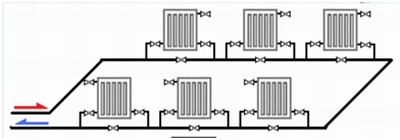
The pipeline can be laid above the floor or built into its structure, and it must be enclosed in thermal insulation in order to reduce heat transfer. Mounting the feeder horizontal line perform with a slight bias, directed along the flow of the coolant. In this case, the radiators should be installed at the same level. To remove air from the system, the Mayevsky cranes are used.
When installing a horizontal one-pipe heating system in a two-story house, it is necessary to start a riser supplying the coolant to the second floor, to the first radiator. Temperature adjustment is carried out using cranes installed on each floor before the first battery.
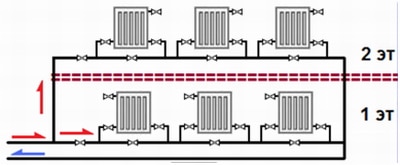
Vertical single-pipe heating system
In this heating system, you can not use circulation pump , because the supply of heat carrier is provided in the process of its natural circulation. Independence from the presence of electricity is the main advantage of this system. The drawback lies in the use of large-diameter pipes and the location of the spreading line strictly under the slope. It is clear that such a pipeline can not decorate the interior of the house. The disadvantage is easily leveled by installing a circulation pump.

Two-pipe heating distribution requires more materials, which affects its cost. Also increases the volume installation works, respectively, and their price. However, such pipe laying provides an even distribution of the heat carrier in the entire heating system. At the same time, it is easier to adjust and adjust the heating system in accordance with the needs of the residents of the house. When installing modern boilers produced by foreign manufacturers, it is welcomed two-pipe heating system , which facilitates the operation of the pump in the boiler.
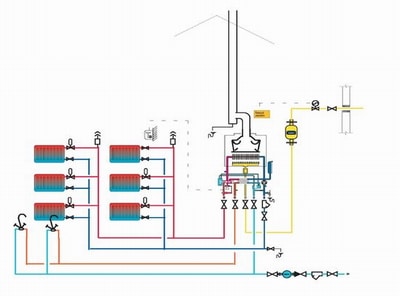
Example of a two-pipe heating system
This is the standard scheme of the heating system, in which the heating of the coolant is provided by a gas double-circuit boiler, which can be both chimney and turbine.
The diagram shows the principle of wiring the heating system and the water mains, the features of connecting radiators. The locations of the regulating and shut-off valves are shown.
Important! When installing heating on several floors of a private house, auto-depressuris valves are required, which are installed at the highest points of the heating system. If the heating installation is carried out in a single-storey house, then these valves are installed on the last radiators, as well as on the heated towel, provided it is available.
In this diagram, the radiators are connected from the side. In addition to the side connection, there are other options, lower or diagonal. At the same time, the type and size of the batteries used influence the choice of the type of connection.
Important! Do not forget about the control thermostats installed at the entrance to the radiator and at the outlet from it. A drain cock is also needed, which is located at the lowest point of the heating system.
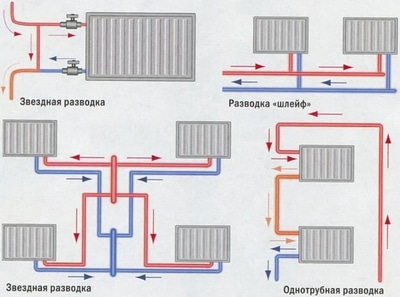
Connection options for radiators in approximate form
Depending on the choice of the wiring diagram (two-pipe or single-pipe), the flow of pipes required for the installation of the system depends. Private houses with a large area are equipped with a two-pipe heating system, into which the circulation pump is additionally cut. Temperature control in each heated room is carried out with the help of temperature controllers. If the budget is small, then a single-pipe heating system is installed. Houses having a heated area of up to 100 square meters, can be equipped with heating systems operating on the principle of natural circulation.
We hope that we managed to show the options for heating distribution in private houses, as well as the features of their installation. The design of heating systems is a complex operation, to which it is better to attract professionals. This will avoid annoying mistakes that may occur during the operation of the heating system. In order not to eliminate errors and shortcomings, it is better to anticipate everything in advance.
Modern, cozy and warm vacation home - a dream of many of our compatriots. But, to provide such characteristics of the house, it is necessary to take care of the preparation of the heating system in advance, carefully plan everything, paying attention to even the smallest details. Only in the event that the planning, selection of a heat generator and heating distribution in a private house with their own hands or by the specialists of heat engineers are performed competently and qualitatively, it is possible to provide the best living conditions.
The main types and layout of the heating system in the house
At present, the scheme of heating distribution in a private house is selected at the design stage. This approach will allow to solve all heating tasks in a complex way, fully fit into the available budget and exclude various unforeseen costs and unpleasant situations.
It should be noted that in private homes (both small dacha and large mansions) several basic schemes of heating are used:
- Single-pipe scheme for heating a private house. The favorable price and ease of implementation make such a scheme the most the best choice for any home;

- Two-pipe distribution of pipes for heating the house. It is more expensive than single-tube, but at the same time, it is characterized by efficiency, productivity and quality.
Single-pipe layout of the heating system: features and design options
The home heating distribution, which implies serial connection all heaters, is single-tube. The peculiarity of it can be called the fact that the coolant (water, antifreeze) enters the heating radiators alternately, gradually giving off the initial heat. In other words, a single pipe is used to supply hot water from the boiler.
At the same time, the cooler is almost completely cooled to the latest radiator of the system. In order not to reduce the level of comfort, single-pipe circuit can be further upgraded, for example, by increasing the number of sections of the last battery in the circuit.

Council. In order to replace the radiators without any complicated and laborious works in the two-pipe heating scheme of the house, it is recommended to mount special cranes at the entrance to each battery and bypass.
Modern single-pipe heating pipes in a private house can have several options:
- The horizontal ("Leningradka"). As you can judge from the name, all the pipelines of the plan are laid horizontally (a slight slope is possible) above the floor or inside it. Radiators should be located at the same level and using special Mayevsky cranes.
Horizontal schemes of heating a private house can even be done by hand in two-story cottages. True, to implement such a system will have to put the riser to the second floor to the first radiator. In this case, the adjustment of the coolant temperature will be carried out using special cranes installed before the first battery of each floor;

- Vertical scheme of heating distribution in a private house. A special feature is the presence of natural circulation of the coolant in the system, as well as independence from electricity. Disadvantages lie in the use of elements of large diameter, as well as in the impossibility of hiding the elements of the plan in the walls or floor of the room.
Two-pipe heating plan
To say that such a system is better than a single-tube system means that there is nothing to say at all. Due to the use of a separate coolant supply pipe and a single return to each of the radiators, it is possible to significantly improve the efficiency of heat transfer, and to ensure significant savings in heating.
In addition, various thermostatic valves, radiator regulators and balancing valves are actively used, due to which it is possible to balance the supply of heat through the batteries, reaching a certain stable level.
It is generally accepted that due to the application of several more materials and components (and this is evident in the photos and videos presented on our website), the two-tube plan is more complicated and times more expensive than the one-pipe plan. But this is not entirely true, with a competent approach to designing, selecting units and assemblies, and also a coolant, you can save a lot on heating even the largest house.
The implementation of two-pipe distribution of heating in the house is possible in two versions:
- . The feed pipe rises to the highest point of the house (usually in the attic), from where each pipe has its own "beam". It turns out a kind of "sun", the center of which is the boiler, and the rays - the pipes to the radiators;
- It is considered the most productive and effective. In the attic is mounted special device The collector, consisting of pipes, distributing the supply of coolant. Also, it is mounted here stop valves, thanks to which it is possible to cut off each of the circuits of the circuit.

Council. When routing heating to two-pipe system It is necessary to take care of the installation of special control thermostats. Also, it is important to install a drain cock, its place at the lowest point of the heating system.
When organizing the heating of your private home, each landlord is faced with the task of considering all the options for distributing heating throughout the house and choosing the most suitable one. There are not so many options, but the differences between them are significant. To stop at the optimal one, one must understand the features of the operation of a particular scheme and compare them with its requirements. Then it will only be necessary to select the appropriate equipment, materials and mount the system. In this article, we will focus on the question of which heating wiring is used in a private house and consider different options.
Of what to choose?
By the way of functioning water heating there are 2 types:
- with the natural flow of the coolant (otherwise - a gravitational or gravity flow diagram);
- with circulation, induced by a special pump (forced circuit).
In addition, the wiring can be one- or two-pipe. In the first case, all heating appliances are connected to one manifold passing through one or several rooms. In the second scheme, pipe routing provides for the connection of radiators not to one but to two distributing pipelines - supply and return. We propose to consider in detail the options that are most preferable for gravity and pumping systems.
The natural circulation of the heating medium is due to the fact that hot water at the outlet of the boiler, having a lower density and weight, is displaced by the cooled coolant coming from the pipeline network. After all, its density and mass is greater. There is a small pressure difference, which determines the natural flow of water in the pipes. However, in this case, the layout of the heating wiring in the house should provide for considerable slopes of the mains and increased pipe diameters.
Recently, cumbersome gravity systems were considered a relic of the past. Today, when people began to strive for energy independence, a tendency appeared to return such schemes to the sphere of private house-building.
Forced circulation of the heat carrier is made by means of a pump, which makes it possible to implement branched schemes for wiring the heating systems. The undeniable advantage of such a wiring is the small diameter of the pipelines and the wide possibilities for their laying, since the slopes here are quite small.
Distribution of the gravitational heating system
It is important to properly distribute the heating from the boiler, otherwise the circuit will not function properly. Due to the fact that the pressure in the pipeline network is small, natural circulation can work well in one- and two-story houses with a total area of up to 250 m2. In more impressive buildings, it is not recommended to arrange such systems.
In a small one-story house, where the number of radiators does not exceed 5, you can apply a single-pipe scheme with the Leningrad wiring shown in the picture:
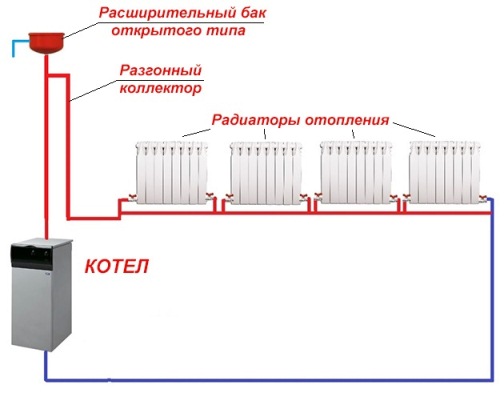
"Leningradka" is a horizontal wiring with the laying of the trunk above the floor (or under it) and the lower connection of the radiators. An important detail, without which the circuit will not work - a vertical vertical riser. To him joins expansion tank open type. By the way, at gravity flow membrane tanks can not be put, because they are designed for work under pressure.
When the area of a single-storey building reaches 100 m2 or more, or the number of batteries exceeds 5, "Leningrad" is no longer suitable, we need a two-pipe horizontal wiring. The return collector is located at the bottom of the floor, and the feeder is at the level of the windowsills (to pass under them) or under the ceiling. In the latter case, it is not necessary to specifically make the overhead riser, the main line will rise to the required height, as shown in the diagram:

When it comes to two floors, here it is often used as a one-pipe system Heating with the upper distribution of the flow and vertical risers. The return collector is located above the floor of the first floor, and the supply is located under the ceiling of the second floor or in the attic. Open the expansion tank, as always in its place - at the highest point:
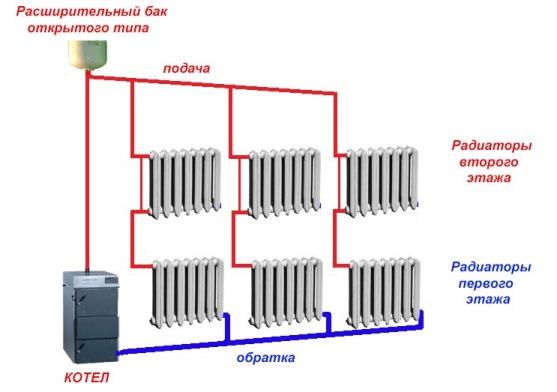
Such an upper distribution of the coolant should ensure its uniform flowing into both the radiators of the second floor and the first one. For this purpose, bypasses are installed between the supply pipes of the second floor batteries, whose diameter is 1 size smaller than the vertical riser. Presented single-tube heating tested in practice for many years and proved to be a good one. This way wiring for the natural circulation of the coolant is exhausted, probably one of 3 options is suitable for your home, if only it is small in size and low number of storeys.
Wiring for forced circulation of coolant
It is worth noting that, when included in the pump scheme, the choice of ways to deliver heat to the radiators is somewhat wider, among them one of the innovations is the radial distribution of the heating system. But first things first. As with the natural flow of water, the famous "Leningrad" is applicable here, only the expansion tank is used membrane type and put it on the return highway. Upper riser is not required, its role is performed by the pump:
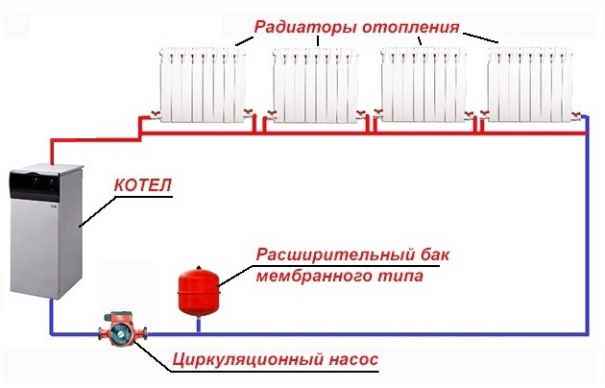
One-pipe "Leningrad" is convenient because it is possible to make the heating system self-heating, and with minimal costs. But the conditions for its reliable operation are still the same: a small area of housing and no more than 5 batteries on one branch. It is also possible to use the single-tube vertical and two-pipe distributions shown above, but this is not always appropriate. In private houses of any area and number of storeys, the following types of schemes with forced circulation are popular:
- with a lower horizontal wiring;
- collector piping (beam).
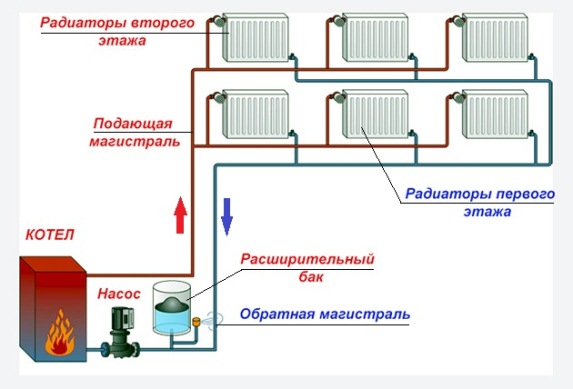
The bottom horizontal gasket is the most popular of all existing circuits. The diameters of the pipes are small, and the pressure created by the pump makes it possible to arrange several dead-end branches of equal length covering the whole house. In addition, the highway can be hidden under the floors or for decorative screens. The traditional lower distribution of heating pipes in a private house with 2 floors is shown in the picture:
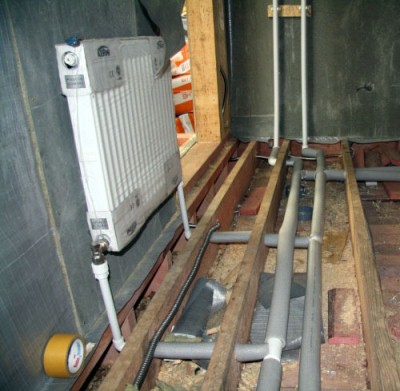
Note. There are other ways of distributing two-pipe pressure networks, but they are not so popular, because then most pipes are located in the middle of the walls and are very noticeable. Below are the schemes of such spreads:
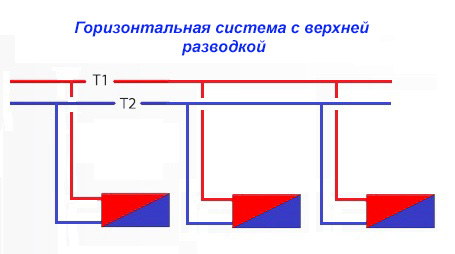
Well, the most "advanced" beam distribution is done in houses with a large number of radiators. To do this, on each floor of the building distribution manifold, from which there are individual branches to each battery.
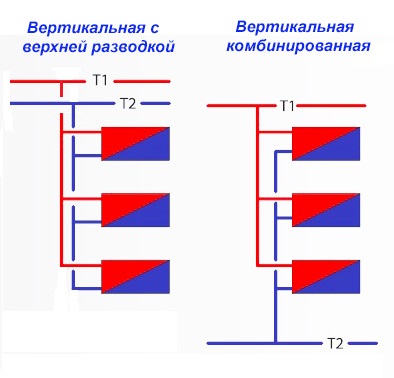
This node is the same as used in warm floors, it connects to vertical riser, passing from the boiler through all floors.
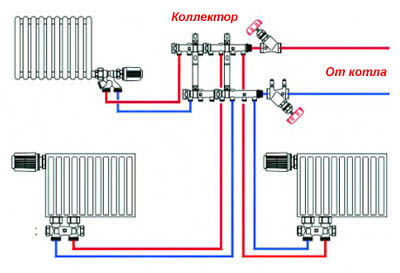
From the point of view of hydraulics this is the best option, but at the most expensive cost. He has one drawback - the gasket is only possible during the new construction, and in other cases it will be necessary to chop gates in the floor. Pipes are hidden or embroidered in it, clad in a heat-insulating shell. As radiators are placed radiators with a lower connection.
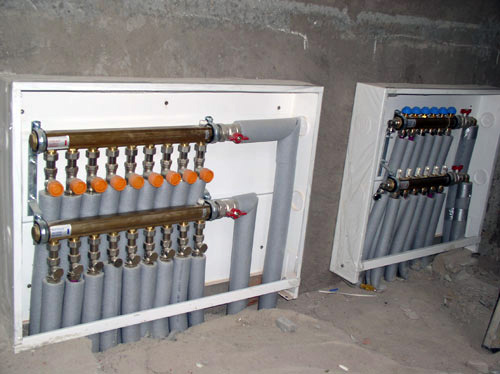
For reference. For those who plan to heat water in the boiler room for hot water, we inform that the distribution of the heating system from a two-circuit gas boiler is performed in the same way as with a simple single-circuit heat generator. Only piping in the piping leading to the consumers of hot water is added.
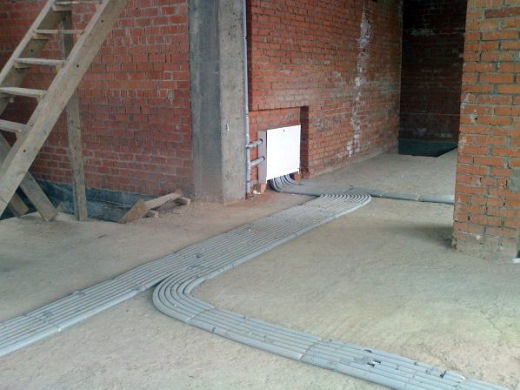
Conclusion
By choosing the wiring, it is worthwhile to think not only about saving materials, but also about the further reliable operation of the system. Before you stop on some version, coordinate your actions with a specialist in this field.
In addition, we recommend that you familiarize yourself with the detailed guidance, .













